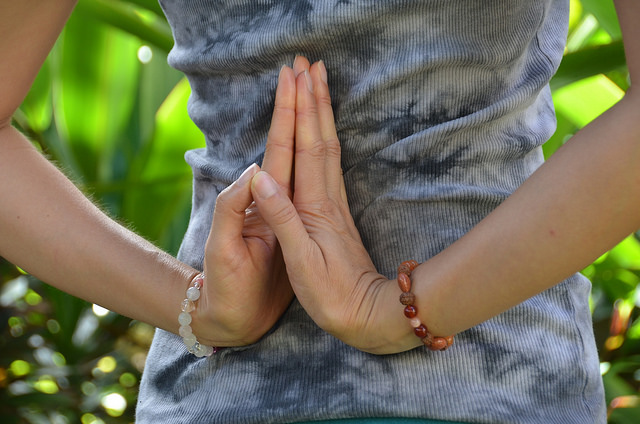
How Does Our Yoga Practice Feed Us?
More than 20 years ago I decided that I would ingest only foods that would contribute to my health and well-being, and avoid “non-foods” that have no nutritional value, things like chemical-ridden processed foods and zero-nutrition soft drinks.
I haven’t eaten meat since 1978, and spent about 12 years on a vegan diet before returning to eating occasional eggs and goat yogurt and chevre. I eat local, organic and homegrown foods whenever possible and always cook from scratch. Fortunately, I love to cook.
There are times when I enjoy eating decidedly unhealthy sweet treats at people’s homes or on special occasions. I’ve tried being a dietary taskmaster with myself, and found the “middle way” to be the healthiest path.
I found that when I got too attached to a strict diet, my ego latched onto it and the diet became an expression of who I was. That didn’t feel healthy. The treats I occasionally indulge in are just that: treats. They are not my mainstay, but they do help keep me from falling into the trap of dietary self-righteousness, a common malady among healthy eaters. Plus, treats are fun and sometimes they hit the spot.
I like Michael Pollan’s advice:
“Eat food, not too much, mostly plants.”
Despite my occasional diversions, my everyday diet is healthy, whole, organic food that contributes to my well-being. When I frame my diet this way I don’t feel at all deprived because I know that everything I eat counts.
I had the good fortune to spend the past weekend immersing myself in a yoga workshop with Jenny Otto at Mindful Yoga Collective in Salt Lake City. Not only was it wonderful to get to be a student, but it was also inspiring to see how Jenny’s work has evolved in the five years since I saw her last.
As with most workshops I’ve attended over the decades, my mind is swirling with new ways to understand my practice. The idea that occupies the forefront for me at the moment is this: In the workshop, Jenny spoke about how her asana practice is now 100 percent about making choices that create health in her body. She stated that she no longer has time for practicing poses that might be risky or poses that don’t in some way contribute to balancing the imbalances in her body.
Like Jenny, my yoga practice has organically moved in the same direction. I’ve crossed a lot of poses that I once loved off my practice list. Extreme backbends? Nope. Headstand? Nope. Extreme hip openers? Nope. It’s not that my body won’t still do these poses. It will. But I realize that there are physical consequences that I’m no longer willing to abide. Living without pain, being able to walk and moving with fluidity are now more important to me than achieving fancy poses.
My practice has become very simple. It feels good—at least physically.
On the other hand, my ego has not always been pleased with my change of direction. I’ve had to drag it kicking and screaming into simpler practice. I’ve felt periodic remorse about giving up fancy poses. For decades, a fair amount of my self-worth was dependent on being a person with a body that can do anything and rarely suffer any negative consequences.
Who am I if I don’t do fancy poses? But bodies, like everything else, change, as do our minds and hearts.
Decades of meditation practice have taught me that everything changes. Some changes are easy to abide; others not so much. The changes that cut deepest are the ones that challenge our notions of who we are. My body’s ability to perform fancy poses gave me a sense of worth. But as my teacher once said to me:
“If you are basing your happiness on things that will change or go away—your home, your job, money, relationships, even your body—you are in for a lot of suffering.”
The Gift of Intention
When Jenny—who has also enjoyed busting fancy poses—told us of her modified intentions for practice these days, it gave me permission to embrace the ways my own practice has changed. While my practice has naturally evolved toward simplicity over the years, I’d never actually changed my intention for yoga practice, as I did with my diet.
In setting the intention to practice only poses that serve my body and mind as they currently are, giving up some of my former favorite fancy poses feels like a gain rather than a loss. Giving up fancy poses contributes to my health and well-being in the same way practicing them once contributed to my self-esteem.
“But I like fancy poses,” you say. Fancy poses are fun. I agree. But looking back in hindsight, I sometimes wish I hadn’t made them a staple of my yoga diet back in the day.
My joints are often cranky and I sometimes move with less fluidity than I would like, at least partly because I made extreme yoga so important. So here’s what I recommend: Practice fancy poses sometimes. Have fun with them. But think of them as dessert.
They provide the same kind of instant gratification as sweet treats, but like sweet treats, they can also take a toll. That adrenaline rush you get from extreme backbends will bring an edgy exhaustion later on, and over-stretching your joints may feel good now, but they may not weather well over time. Make the basics your staples: standing poses, balances, easy backbends, simple twists, forward bends. A simple, mindful practice provides sustenance. Extreme yoga is fun in the moment, but may leave you with the yogic equivalent of a sugar hangover—not to mention chronic imbalances later on.
Our bodies and minds are constantly evolving. It’s part of being alive. If your yoga practice is to stay healthy and vibrant, it will evolve too. Of course, the way your practice or my practice evolves is entirely up to us, and depends on the truth of our bodies and minds in the present moment. Be open to what your body and mind are telling you and revisit your intentions for practice. It’s okay for practice to change. An evolving practice is a living practice.
Love elephant and want to go steady?
Sign up for our curated daily & weekly newsletters!
Apprentice Editor/: Edith Lazenby Editor: Rachel Nussbaum
Photo: elephant archives via Flickr






Read 4 comments and reply